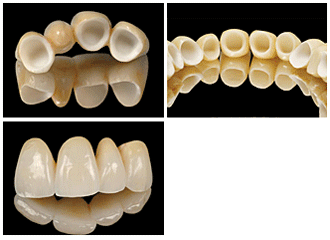
Schedule
Mon 8:00 am to 8:00 pm
S. 10:00 am to 4:00 pm
Book your appointment
(506) 2261-3327
Aesthetic restorations
The aesthetic demands of patients have stimulated great advances in the development of new dental materials, always seeking that their behavior is similar to that of dental tissue. "The main objective of modern dentistry is to provide patients with restorations with optimal aesthetics while avoiding as much as possible the undesirable effects of metals."
A large number of options are presented to restore both the anterior and posterior segments with metal-free systems. Ideally, this should have characteristics of high resistance, translucency, adequate marginal adjustment and biocompatibility; that is, they provide aesthetic and functional qualities comparable to those of the natural tooth structure.
Crowns are restorations that are used for the complete replacement in artificial form of the crown of the tooth, that is, of the part that we see of any tooth. They are indicated when there is great loss of tooth structure, which makes it impossible to retain any other filling or the risk of tooth fracture due to little tooth remnant.
The new metal-free porcelain crowns have replaced the old metal-porcelain crowns in the aesthetic areas of the mouth, since they allow us to achieve a much more luminous and natural appearance, in addition to eliminating the problem that arose when gum recessions occurred. with the consequent appearance of a black halo around the tooth.



The advantages of porcelain without metal are
-
The high precision and its perfect adaptation, in addition to the biocompatibility and its excellent biomechanical properties, offers individualized restorations with very high aesthetics.
-
Translucency provides the vitality that, together with veneering porcelain, makes it almost impossible to distinguish a restoration from a natural tooth. Crowns and bridges can be cemented using conventional cements or adhesives.
-
The aesthetic results that can be achieved are amazing.
-
The restorations do not contain any metal alloys, which means that the risks of allergic reactions are zero. This results in a good response from the soft tissues surrounding the tooth and maintains the health of the gums around the restorations.
Aesthetic veneer restorations
A porcelain veneer is a more or less thin sheet that covers the entire front face of the tooth, adhering to it by means of a certain type of resin cement (not externally visible).
Porcelain veneers, as well as crowns, are used in cosmetic dentistry treatments as a solution to rebuild a smile damaged by an alteration in the color of the teeth, allowing the patient to return to a perfect smile.
The placement of porcelain veneers is a treatment on the rise in the dental sector that even allows the patient to overcome the insecurity caused by showing his old faulty smile.
By not requiring a very complicated or painful intervention, and by presenting excellent results (in duration and natural appearance), the placement of porcelain veneers is a highly demanded reconstructive technique among aesthetic dental treatments, especially in those cases in which the rebuilding a smile is more complicated
Inlaid porcelain restorations
Another type of aesthetic restoration is Inlays, which are indirect fillings that we use to restore posterior teeth, these are sent to the laboratory for which it is necessary to take a mold. They are used when there is still enough remaining tooth tissue.

